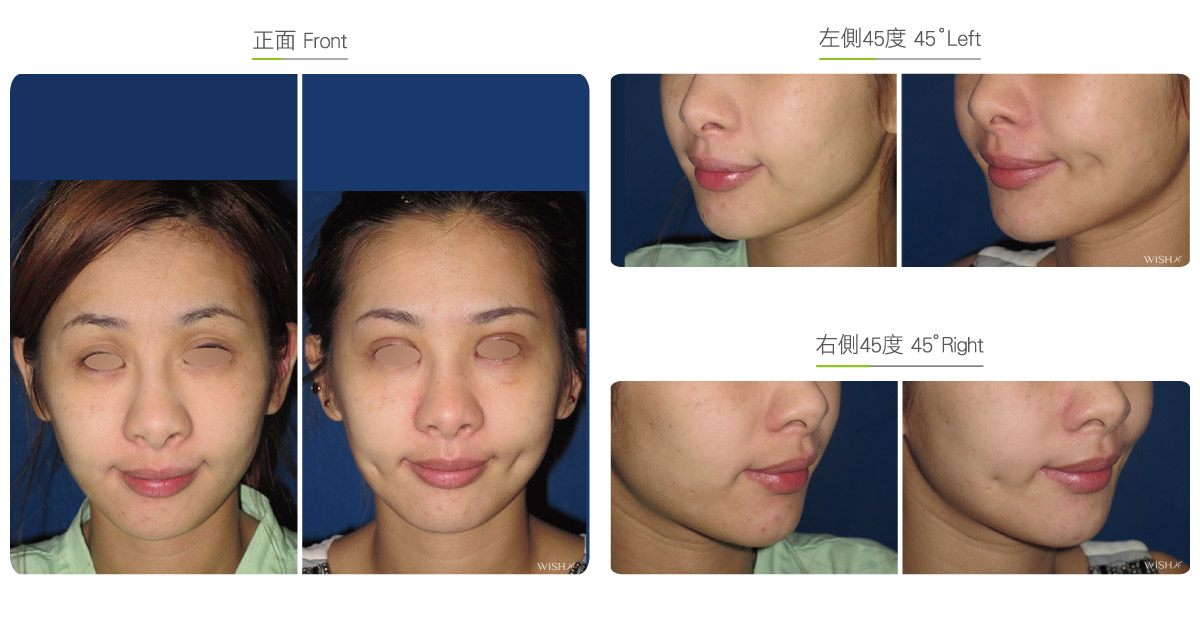Dimple Surgery
Dimples have long been deemed a sign of a sweet smile among females. They are formed as the dermal layer lateral to the mouth corner connects with the spotty fibrous bundles of the facial expression muscle (risorius) fascia inferior to the cheek, which gives rise to a circular or oval indentation along with the motion of the muscle. Generally, dimples are hereditary and are symmetrically distributed on both sides; they may also be formed by facial expression training and thus be present at only one side. The positions of dimples are also varied, most frequently at approximately 2 cm lateral to the mouth corner, namely the intersection between the mouth corner parallel line and lateral canthal perpendicular line.
Several methods are available for dimple creation surgery, which are all for forging skin adhesion to the underlying muscle at the specific position of the cheek. At present, Dr. Chuang utilizes the intraoral annular incision method. A 1-cm incision is made at the intraoral mucosa corresponding to the dimple, and after a few muscles and soft tissues are removed, muscles are stitched from the defect inferiorly to the dermal layer with a non-absorbable suture to create an adhesion between the muscle and skin, thus producing an indentation at the dimple and enabling the depth of the dimple to change along with the traction of muscles.
Clinically, dimple surgery may not be suitable for all patients; it is not indicated for those with emaciated cheeks, a sharp face, or obvious nasolabial folds; otherwise, the cheek would appear more sunken. If the patient’s cheeks are too fat or chubby, the difficulty in stitching and fixation of dimple compromises surgical results and persistence of results. Moreover, a temporary cavity would be left on the cheek in the early postoperative period, which is present regardless of the facial expression. It takes an average of 2–3 months for the dimples to show dynamic changes along with mouth motions and results to become gradually natural. Therefore, patients should consider the recovery characteristics of such a surgery before doing making their decision.
Surgical conditions
Duration
- Type of anesthesia: IV sedation + local anesthesia
- Type of incision: Approximately 1-cm incision at the intraoral mucosa
- Recovery: 2–3 days
- Removal of stitches: No
General instructions
No food and water on the day of surgery
- Avoid excess irritating or hard foods for 1 week postoperatively.
- Avoid laughing or overt mouth opening behaviors for 1 month postoperatively.
Ideal candidates
- Patients who want to artificially sculpt dimples
- Those who want to redress congenital dimple asymmetry
- Those who want to deepen the indentation of the congenital dimple
Possible complications
- Premature suture sloughing
- Cheek skin concavity (temporary)
- Asymmetry at both sides
Surgical advantages
-
The surgical incision is small, and the recovery is fast.
-
The wound is inside the mouth, and no scar will be noticed on the skin.
-
The position of the dimple is changed based on the patient’s face shape conditions and subjective requirements.
Surgical drawbacks
-
There may be temporary cavities for 2–3 months postoperatively on the cheeks.
-
Dimple sutures may prematurely slough due to frequent or overt mouth motions.
-
Acquired dimples may be not as natural as the congenital ones.
-
Surgical results are not persistent.

